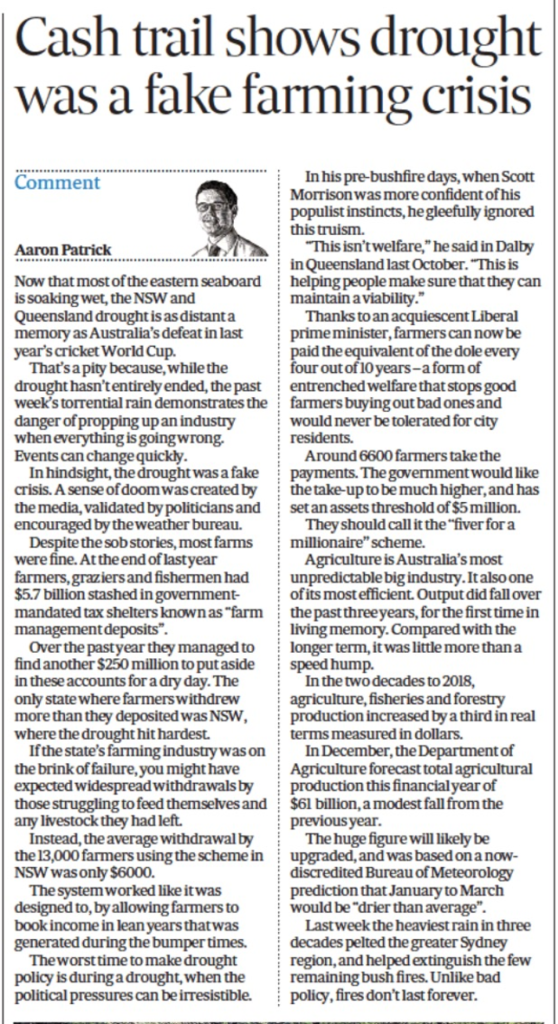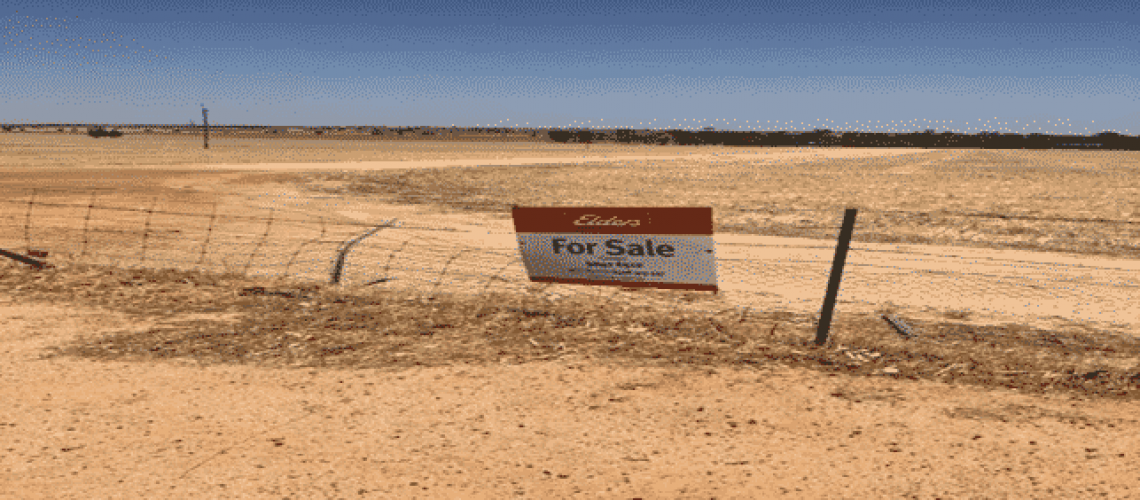A recent article in the Australian Financial Review titled Cash Trial Shows Drought Was a Fake Farming Crisis by the influential national political commentator Aaron Patrick is yet another example of how a city centric commentator can misunderstand the complexities of Australian agriculture.
Patrick’s thesis is that the national drought is a fake crisis and despite the sob stories (his words) the agricultural sector was just fine, proven by the fact that the amount of money stashed away in Farm Management Deposits (FMDs) has not collapsed over the course of the drought.
The FMD scheme was established in 2009 following the end of the millennial drought which ravished parts of the eastern states for nearly a decade.
Over the following years FMDs grew to total $6.6 billion by June 2018 before falling away as a result of the first year of the drought down to $5.37b in March 2019, before growing to $6.7b in June 2019 then back down to $5.63 billion at the end of January 2020.
They are not being run down to zero as Patrick imagines they should be simply because the vast majority of farmers with them either use them for seasonal financing or have access to cheap capital something many farmers with no FMDs and low equity don’t have.
With only around 1 in 4 farm businesses having FMD accounts and 43% of the 45,000 accounts being held by larger farmers with turnover between $1 and $5m a year, there is obviously a structural weighting towards larger more profitable farm businesses being able to build reserves. The challenge government faces is what to do with the 3 out of 4 farms that don’t have FMDs, the vast majority of which are relatively small enterprises.
While I tend to agree with Patrick’s overarching view that the current mix of drought policies rolled out over the last 18 months reek more of political desperation aimed at saving seats than farms, to simply focus on farm management deposits as the gauge of the state of national farm financial health is not just naive it is unprofessional.
One phone call to any one of the hundreds of farm accountants across Australia would have pulled apart such simplistic thinking and build a picture of an industry challenged by not just debt, but scale and access to risk capital.
As an industry we need to have a frank discussion about drought support and what is government’s role.
If the government is serious about drought policy it would go back a decade to the last national drought forum and lock in around the then agreed national position which is that farmers have a responsibility to prepare and manage for drought while governments support the community and mental health side of the equation.
Governments are not there during droughts to buy water from desalination plants in South Australia to grow expensive hay nor should they throw money at local councils which ends up favouring Busselton over Dundas (Norseman).
The government’s role is to create the tax and financial conditions that allow farmers to access capital when they need it, not throw cash when the dust blows.
Our eastern states farming cousins who demand the most from government have to understand something that Western Australian farmers worked out a long time ago, that is governments cannot and will never be the lender of last resort, nor are they responsible for providing water and fodder for livestock no matter how loudly the wireless howls with the sounds of radio talkback hosts like Alan Jones berating the government to do more.
Hence, I disagree with Aaron Patrick on the issue of the importance of Farm Management Deposits. As a reserve to tap into when credit dries up this financial instrument makes eminent common sense and it seems the vast majority of farmers who have built up their reserves have been well prepared to manage their way through this drought without having to draw upon them.
Come a third, fourth or fifth year of drought, fire, flood or market collapse due to pest, disease or market failure then they will no doubt drawn down very rapidly.
It’s those who don’t have FMDs and who are demanding ongoing government farm subsidies or farm income support while sitting on assets of up to $5m that needs to be reviewed. Patrick is right to call them out as farmers that have access to a form of dole four out of every ten years no questions asked. A welfare benefit that would never be tolerated by most of the farming community if it was directed at city based workers.
Farmers know it’s not welfare that keeps farmers farming it is access to capital, hence it’s time we moved on from drought subsidies and have a debate about ending farm welfare and fixing the problem of access to risk capital for those who want to farm on when the rains stop and their equity falls.
If the government is serious about farm financial resilience in tough times it needs to up the FMD limit to reflect the growing size of farm businesses and reduce the tax rate at which they can be withdrawn to the new company rate of 25%. In addition, they should be looking at ways to help end the penalty interest rates that banks hit farmers with when their equity drops to arbitrary thresholds that are out of whack with the risk banks face.
While the banks are happy to lend on 5 or 10% deposit on a million dollar apartment to someone with less than 12 months work experience, they demand 30% – 50% farm equity from highly experienced farmers simply because of the supposed high risk nature of the underlying asset.
Anything less and the interest rates head towards double digits.
This defies the history of the long term stability in farm land values and the steady capital gain seen across the sector over the last fifty years, something that cannot be said for inner city apartments.
The one thing that is not in short supply is sky to build sky rise apartments whereas we ran out of farm land to clear forty years ago and since then with the growth of state parks, urban areas and environmental restrictions Australia’s farm land has been steadily diminishing in area. But this logic does not seem to have entered the banks risk matrix and they continue to target farmers with penalty rates.
Penalty interest rates are not uncommon on farm businesses that still have substantial equity on their balance sheets.
This is a story the Australian Financial Review should be delving into rather than critiquing FMDs based on virtually no research as to who has them, when they need to access them or why they are not withdrawing them.
In the case of the farms that are under serious financial stress and which don’t have FMDs, what they really need is not an annual $14,000 welfare cheque from government and penalty interest rates but access to long term capital at reasonable rates of interest.
What won’t provide this capital is mad cap drought policy on the run, ideas like the government’s Rural Investment Corporation RIC better known as Barnaby’s Bank with its $4 billion in reserves designed as a drought support mechanism.
As a means of supporting farmers it is a failed policy, having so far lent out less than $1 billion dollars during one of the biggest droughts on record, far short of the billions needed to refinance the industry into this year’s crop or to cover the cost of restocking.
What political commentators in the AFR should be exploring is why hasn’t the government looked for a private solution to a private problem. What the industry needs is more competition in the rural financing sector and banks to change their attitude to backing farmers when their equity levels fall.
One possible solution to changing attitudes to farm risk that was recently put up to the government is some form of farm income protection insurance scheme. While this has been tried before with multi peril farm insurance and failed, what is needed is a more sophisticated financial model that does not rely on the reliable rainfall regions carrying the more marginal areas.
Government should be prepared to fund the economic and weather modelling for Australian conditions that will help the private insurance sector cover the industry with some form of risk cover.
Another idea is a short term underwriting scheme to give the banks the confidence to lend to low equity farmers. Just as the government introduced the first home owners scheme last year putting aside $500m to underwrite mortgage insurance for 10,000 households. A similar scheme could be introduced to cover borrowings when farm equity falls to 20% thereby preventing penalty rates on stressed farm balance sheets for those who want to throw the dice and plant or restock after a drought.
It would be of little risk to Treasury and might even help banks get over their inherent caution of treating farm loans as high risk while financing endless apartment blocks in big cities. What we need is the government to rethink its drought policies and focus on access to credit and cash, more flexible tax rules on withdrawing FMDs and a financial sector willing to back farmers when their equity falls.





